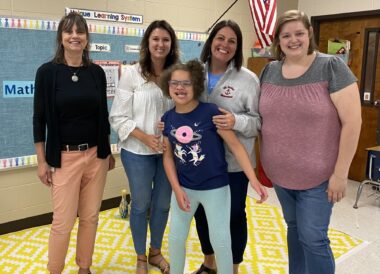How we made the right choice for our Angel’s middle school classroom
Choosing the right fit for special education in middle school

Sixth grade is just about over for my 13-year-old Angel, Juliana. The year has gone well despite the tough decision we faced with school choice. When you’re transitioning to middle school in special education, your home school and your student’s abilities all come into play. I didn’t know what the process would look like.
Last year at about this time, we were celebrating the end of elementary school. As a former fifth-grade teacher, I love the fifth-grade parade when students walk the halls and everyone cheers. Last year, it was Juliana’s turn, and I wondered how she would handle the noise.

Juliana is overjoyed as her teacher presents her with a rose at the school’s 2022 fifth-grade parade. (Photo by Sabrina L. Johnson)
Loud noises, crowds, and changes to her routine can sometimes trigger anxiety for Juliana. I brought noise-canceling headphones for her, but she didn’t need them. She walked the halls like a rock star. It was bittersweet saying goodbye to the teachers and staff who had worked with her for so long. However, it was time for the transition to middle school.

Juliana, center, poses with the teachers and therapists who supported her throughout elementary school. (Photo by Sabrina L. Johnson)
Where do we go?
I felt ready for all the little details like changes to our schedule and a longer day. But when it came to school choice, I was in the dark. Initially, we received incorrect information, and getting to the right point of contact was confusing. Eventually, the lines got uncrossed when we met support services administrator Erika Beck.
I’ve heard many horror stories about transitions like ours. Fortunately, there are real people like Ms. Beck who go the extra mile and make the process clearer. It was her truthful, professional compassion that helped us make the right school choice.
In our district, classrooms vary based on the severity of the disability and a student’s abilities. Juliana doesn’t have medical issues that prevent her from working in school. However, she needs assistance with daily tasks like eating, toileting, and transitions. Challenges like these are typically addressed within a self-contained severe/profound classroom known as SID/PID.
Finding the right fit
All throughout elementary school, Juliana had been in a moderate intellectual disability classroom (MOID). It was the best placement for her when we transferred from early childhood. Her MOID classroom had a mix of learners, and the teacher made the class challenging but doable with the help of an assistant.
When we toured the schools that could accommodate Juliana for sixth grade, we saw both classrooms. When Ms. Beck suggested the SID/PID classroom, I was hesitant. I felt like Juliana was being demoted. Normally, the teacher would make a recommendation for placement, but Juliana’s teacher was new and deferred to Ms. Beck.
Ms. Beck came to Juliana’s classroom to observe, and afterward, she advised SID/PID. I listened through tears, fearful that choosing SID/PID would give Juliana a less challenging learning experience. I took a lot of notes during our tours and meeting. Afterward, I made a long list of pros and cons. In the end, my husband and I chose the SID/PID classroom.
Just right
The biggest struggle with our choice was letting go of my impression of what the class meant. SID/PID is not a demotion. Juliana is in a classroom with her peers and she is doing well. As she did in elementary school, she’s making a name for herself in her new environment. She has been recognized twice for her artwork. Most importantly, she’s practicing daily living skills like tooth brushing and learning how the real world works through community-based instruction. Credit goes to her teacher and the staff who support her. Ms. Beck has also been at the forefront making sure that Juliana is adjusting well.
Making the right school choice for your Angel can be difficult. I don’t recommend doing it without facts and a knowledgeable staff member. As an educator, I’ve seen the results of classes that are too hard or too easy for students. I didn’t want that for Juliana.
At the end of an emotional decision, I think we got the fit just right.
Note: Angelman Syndrome News is strictly a news and information website about the disease. It does not provide medical advice, diagnosis, or treatment. This content is not intended to be a substitute for professional medical advice, diagnosis, or treatment. Always seek the advice of your physician or other qualified health provider with any questions you may have regarding a medical condition. Never disregard professional medical advice or delay in seeking it because of something you have read on this website. The opinions expressed in this column are not those of Angelman Syndrome News or its parent company, Bionews, and are intended to spark discussion about issues pertaining to Angelman syndrome.








Leave a comment
Fill in the required fields to post. Your email address will not be published.